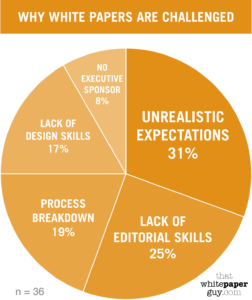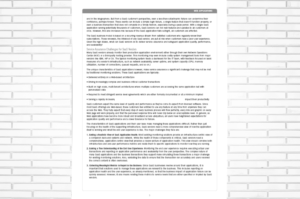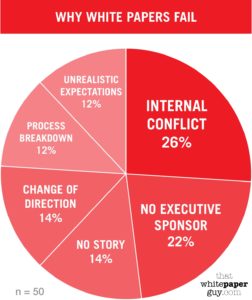
5 reasons white papers are challenged: data and stories
Let’s compare a white paper to a dessert soufflé.
Done right, a soufflé is an extraordinary dessert that gets people talking.

But making a great soufflé takes the right ingredients, the right recipe, and an oven and soufflé pan in tip-top shape.
If you’re missing one of these, your soufflé will fall flat.
By the same token, publishing a great white paper takes the right team, the right process, and the right resources.
If you’re missing anything, your white paper will likely fall flat.
I have the data to prove it
At That White Paper Guy, I recently analyzed 300 of my white paper projects going back to 1997.
My research revealed that 36 of these white papers—about 1 in 9 (11%)—did not turn out as well as they could have.
Those papers were challenged by flaws in the editorial content, design, or publishing process.
I’m not talking about the occasional typo.
I’m talking about problems serious enough that the white paper never generates the results the sponsor wants.

Why are white papers challenged?
As shown in the piechart, I found five main reasons why some white papers aren’t as effective as they could be:
- Unrealistic expectations (31%)
- Lack of editorial skills at the client (25%)
- Process breakdown (19%)
- Lack of design skills at the client (17%)
- No executive sponsor (8%)
And there’s one more big issue.
In more than half of these challenged white papers (20 projects or 55%) the client set a budget too low to accomplish what they wanted.
But that’s a whole other topic for a future article.
For now, I have some crazy stories about white papers that didn’t perform as well as they could have.

Two tech giants = Unrealistic expectations
A few years ago, I was asked to write a white paper to support an executive breakfast in New York City co-sponsored by two huge Silicon Valley firms.
One makes computer hardware and the other does enterprise software.
Both companies were going to pool their juiciest contacts to build a must-go event that would electrify the business world and lead to zillions in sales.
I started doing regular conference calls open to both teams. The main purpose was to brief me so I could do the accompanying white paper.
There were usually 15 people from both companies on every call.
Every time someone arrived or left, the conference system would go “Ding! So-and-so has now joined / left the call…” blocking out the next few seconds of conversation.
All I could hear was a constant chorus of “Ding! Ding! Ding!” as people dropped in and out of the call.
On every call, someone would ask, “Why are we doing a white paper anyway?”
At one point, a top guy from the software side said, “Why do we need to use [partner’s] hardware anyway? Our software runs on any system! Why can’t we say that?”
Somehow I managed to put together a short document.
It was 4.5 pages plus front and back matter.
I even cooked up some graphics to show how well the products from the two companies worked together… unlike the people.
Someone slapped both logos on my Word file, and that was it.
The event was held. It didn’t electrify the business world. It didn’t lead to zillions in revenues.
The partners went their separate ways.
And despite the twin big-name logos on that sample, I never show it to anyone. It’s just not good enough.
The two sponsors had unrealistic expectations from their chosen partner and their planned event.
There was no way any white paper was going to drive sales of this joint offering.
The VP with the kitchen sink = Process breakdown
Back in the early days of my white paper career, I was doing subcontracts for another well-known writer.
Our client was the director of marketing at a mid-sized software firm. She was a sensible woman we had worked with before.
Everything went well until I reached the final draft.
That’s when we needed the blessing of her boss, the VP of Sales & Marketing.
The VP—who had not been involved until that point—trashed our draft.
He added buzzwords and jargon to every page.
He pasted in gobs of product information that made no sense at all with the existing structure.
He argued for tossing in everything but the kitchen sink.
I managed to shuffle some of that dreck back to an appendix where it was less obtrusive.
Our client was caught in the middle: between her boss’s ignorant comments and her team’s dismayed pushback.
It was a classic no-win situation.
The final version was a dog’s breakfast, an embarrassment to the team that accomplished none of their intended goals.

The wall-of-grey = Lack of design skills
One white paper I did for a software firm went swimmingly from start to finish.
Or so I thought.
Developing the content was smooth. The reviewers had few comments.
I gave the text a final polish to make sure every sentence was crisp and clear.
The client sent the text to the designer, who they assured me was very experienced.
They paid my last invoice. But I never got to proof the finished paper.
A couple of months later, I got curious and visited the website.
I found the white paper. But when I saw it, I almost cried.
My carefully polished text was unreadable.
Every page was an unrelieved wall of grey.
There was next-to-no white space.
Many paragraphs were merged into one long run-on smoosh.
No matter how hard I tried, I couldn’t force myself to read it.
The total lack of design skills destroyed that project and wasted everyone’s time and money.
These days, with more experience under my belt, I would call back the client and argue for a design redo.

The all-in mashup: Lack of editorial skills at the client
You’ve likely heard my signature theory about the 3 flavors of white papers and how you can’t mash up all three of those flavors into an effective white paper.
While a chocolate looks outward at a big industry problem, a vanilla looks inward at a specific product.
Switching from one perspective to another is like switching from a telescope to a microscope.
You can do that, but most B2B prospects don’t have the patience.
I believe it makes more sense to split off the product details from the industry-wide problem and create two white papers instead of one.
But not everyone wants to do that.
On one project for a very big, very well-known client, the product manager insisted that one paper had to cover everything.
“Everything” included all this:
- A few years of tech history
- Some industry regulations
- Claims and counter-claims from competitors
- Details of a new version of the company’s flagship product
After we had a draft to look at, there was an obvious defect.
It jumped from a numbered list of 5 items to another numbered list of 7 items on the very same page.
After that, the text circled back to describe how the new software handled each of those 7 items.
“You can’t jump from one numbered list into another,” I said. “Let’s separate it out into two papers. ”
The client wouldn’t hear of it.
Believe me, it wasn’t a matter of money.
And it wasn’t a concern that no one would bother to read both papers from this tech giant.
I think the client was told to publish a white paper, so she wanted one white paper. Period.
She didn’t want to hear about ice cream and telescopes and microscopes and competing numbered lists.
Reading over that white paper today, it’s easy to see why it didn’t get much traction.
It just doesn’t make a lot of sense. It tries to cover too much, too fast, all in one document.

What can you do to avoid an ineffective white paper?
A poor partnership, a VP who trashed the process, an inept designer, and a mishmashed structure.
These stories highlight the most spectacular challenges our projects have suffered.
Other white papers have failed outright and never been published.
As a B2B marketer or a white paper writer, what can we learn from these challenged projects?
And what can you do to make sure your next white paper succeeds?
That’s a big question. And you may not like the answer.
As the contract writer, all these challenges were beyond my control. Many were beyond my awareness.
And in almost all of these cases, I struggled with the question, “What else could I be doing here?”
The answer is that we all need to learn more about the skills, process, and resources that go into creating an effective white paper.
And then we need to talk about them. And keep on learning.
Let’s create more successes!
A wise colleague of mine calls white papers “high-risk, high-reward” projects. I think he’s right.
When white papers work out, they pay off big-time and everyone’s a hero.
If the results are limited by poor editorial, design, or publishing decisions, then everybody looks bad.
That’s why I continue to do research and develop fresh tips on how to create successful white papers.
Do you have a challenged white paper of your own to tell us about? Please leave us in the comments below.
Want to hear whenever there’s a fresh article on this site? Subscribe here to stay in the know on long-form content. From time to time, we’ll also send you word about some great new resource or training. And you can unsubscribe any time.





This post is the kind of research I can use Gordon and Angie! Thanks for digging and discovering. I just finished a call today with a guy who had a white paper I liked but had no idea of its value or how to market it. I’ll make as much positioning it as he paid to have it written.
I tell you this because I think your students should read your article closely. Each of the data points you’ve unearthed as a challenge is, in fact, a selling point for those of us who like to write conversion copy. There is high value in proving the worth of thought-leadership work like yours – which is really what your white papers are.
I hope all is great there.
Cheers
David
Hey David: So great to hear from you! Absolutely! The positioning and marketing of a white paper is equally as important as the writing. (Actually, I can already hear the argument for positioning *over* good writing. That said, we’ll always champion editorial quality at TWPG.) Gordon says that the moment to start thinking about how you will promote and distribute a white paper is the moment you start creating it.
Enjoyed and learned a lot in the first mentorship despite experiencing a major setback midway — a personal/professional tragedy preventing writing my sample paper. To bounce back would love to attend another series of presentations; didn’t see any announcement of the current upcoming round. Meanwhile am reading a lot and actually landed six (6) short and sweet “white paper” projects that were successful, according to the client, though by no means as ambitious or challenging or profitable as your examples in this issue, Gordon. Nightmarish examples of Dilbert-like incompetence!
Been there, done that too. Hope I can learn how to market my services anyway.